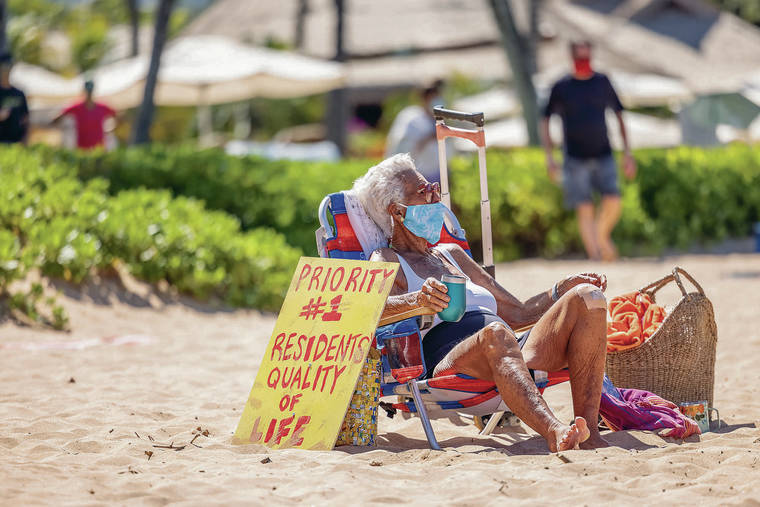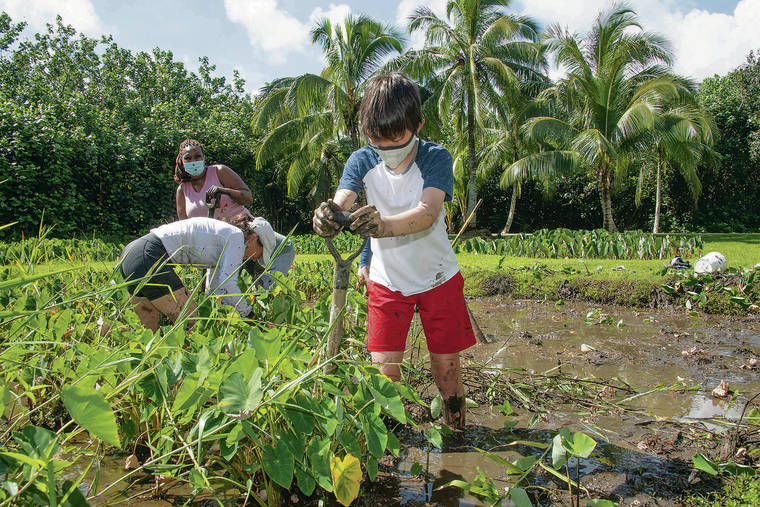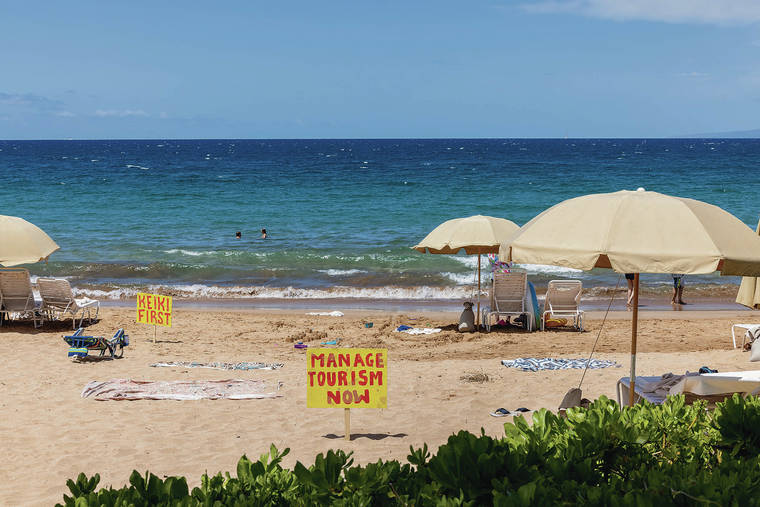Frustrated residents push back as Hawaii tourism resurges

BRYAN BERKOWITZ / SPECIAL TO THE STAR-ADVERTISER
Kihei resident Dorothy McCoy, 93, found a spot on Wailea Beach on Saturday for the “Take Back Our Beach” event organzied by residents.

CRAIG T. KOJIMA / CKOJIMA@STARADVERTISER.COM
Kualoa Ranch is participating in the Hawai‘i Tourism Authority’s Malama Hawaii volunteer program, which is designed to improve the relationship between Hawaii residents and visitors. Simon Pierwola was hard at work in a taro patch on Friday.

BRYAN BERKOWITZ / SPECIAL TO THE STAR-ADVERTISER
Signs were posted along Wailea Beach on Maui on Saturday as part of a “Take Back Our Beach” event organized by residents.



Kai Nishiki and other frustrated Maui residents got up early Saturday and armed themselves with beach chairs, umbrellas and towels to storm Wailea Beach and push back the increasing ranks of tourists who have been flocking to the island, overtaking popular spots locals got used to having to themselves after COVID-19 virtually shut down the visitor industry.
“Residents are uncomfortable in our own space. We want the government and tourists to feel for themselves exactly how uncomfortable we are,” said Nishiki, a community activist who organized the “Take Back Our Beach” event, promising more to come until action is taken.
“Our communities are feeling pushed out and marginalized, as if our only value is to be a backdrop for vacation photos.”
The faster-than-expected pace of the recovery is good for Hawaii’s tourism-dependent economy, but it’s also created a sense of urgency to improve tourism management, especially in pockets of the state that were already battling for balance before the pandemic hit.
Angela Keen, a founder of Hawaii Kapu Quarantine Breakers, said she’s getting complaints from hotel workers and activity providers who are concerned that some visitors “aren’t sensitive to our ways and our culture and our willingness to wear masks to protect our neighbors.”
“Hostility is rising,” Keen said. “The tourism industry needs hooponopono (to make things right) with locals, otherwise they’re going to be at a place where they are trying to bring in visitors and locals are not going to be nice to them. They aren’t going to have the aloha that they normally had.”
Don't miss out on what's happening!
Stay in touch with breaking news, as it happens, conveniently in your email inbox. It's FREE!
Saturday’s “Take Back Our Beach” event calling on residents to pack the beach fronting the Four Seasons and the Grand Wailea resorts was a clear line in the sand against what Nishiki described as “unchecked tourism growth and poor tourism management.”
The Maui County Council has taken notice and is considering measures that would reserve at least half of all public beach access parking for residents, and for visitors to be charged parking fees.
“It’s a quality of life issue,” said Kula resident Kisha Hudson, 42, who was at Wailea Beach on Saturday. “We all work hard to live on this island and there’s so many tourists everywhere right now. I take my kids to the beach on weekends and they don’t even want to get out of the car because A, there’s no place to park, and B, they’re afraid to be around so many people.
“We’re just making a statement so that maybe the mayor sees how we’re feeling about it. Obviously the tourists probably have no idea. They don’t realize there’s this much animosity going on in the island.”
Also on the beach was Michael Rossi, 38, of San Diego, a frequent Maui visitor who said he understands some of the frustrations felt by local residents.
“They feel they need more balance in their state; however, to push tourism dollars away, this state would have a lot of trouble,” he said. “So what I’d like them to know is that tourists, we respect locals a lot, we respect their culture and the land, the majority of us, and we want to exist in harmony, but we also want to enjoy our vacations. This is many children’s only chance to see a beautiful beach on Maui and now there are protesters with signs all over it. It’s a little bit unfortunate.”
Managing tourism
The Hawai‘i Tourism Authority, the state agency in charge of managing Hawaii’s tourism recovery, is even at risk.
The Hawaii Senate has proposed cutting HTA’s coming annual appropriation to $48 million from $79 million. On Friday, the Senate Ways and Means and the Senate Commerce and Consumer Protection committees also passed a new version of HB 862 that would make sweeping budgetary and other changes to HTA.
But more significantly, HB 862 would refocus the agency on its original marketing and branding functions, one of its four pillars, instead of prioritizing new pillars such as Hawaiian culture, the environment and the community. The change would be a significant turnaround from the agency’s pivot toward more of a destination management role after Hawaii surpassed 10 million visitors in 2019 and the impacts generated pushback from some segments of the community and state Legislature.
HTA President and CEO John De Fries said Friday that more than 200 people testified against the changes proposed in HB 862, which comes at a critical juncture for Hawaii tourism.
“Wailea is just the tip of the iceberg. Among the 200 that voiced their objections are people out in the community who are sitting on powder kegs because they don’t want something to erupt,” De Fries said.
“The dismantling of this system called the HTA should bother everyone, because at this moment in Hawaii’s history we are at a tipping point. This thing could go south if these kinds of issues are not tended to in the right way by the right leaders of the community.”
Exacerbating tensions also are part of the reason Ashley Lindsey, a new member of the Maui Planning Commission, was moved to tears last month before deciding to abstain from voting to issue a special management area use permit to allow the Maui Coast Hotel to build a new six-story building with 170 guest rooms. After hours of discussion, the permit was awarded in a 6-2 vote, with Lindsey’s abstention counting as a yes.
“I honestly can’t pick community over environment or, you know, like, jobs,” Lindsey said.
The challenges the Maui Planning Commission faced when deciding to expand an existing hotel in a visitor-oriented district become even more complex when policy makers must regulate the spread of tourism into communities.
There was plenty of angst Tuesday when the city Department of Planning and Permitting held a public hearing on a plan to expand short-term vacation rentals by allowing another 1,700 or so Oahu homeowners to operate bed-and-breakfast units. Several testifiers were disturbed that occupancy at vacation rentals has outpaced hotel occupancy since October, when the state reopened tourism.
HTA Chairman Rick Fried said Friday the agency has come out strongly against illegal vacation rentals as part of its tourism management plan, which would be in jeopardy if legislators cut the organization’s funding and limit its scope.
“We have to have management of tourists,” Fried said. “It’s a dramatic evolution and an important evolution (for HTA), because in my view we don’t need 10 million people again.”
Kailua doesn’t even have a hotel, but conflicts between the needs of visitors and residents often spring from its popular beaches and vacation rentals. State Sen. Chris Lee (D-Hawaii Kai-Waimanalo-Kailua) recently posted a photo on Facebook showing four red convertibles, the kind of rental car favored by tourists, parked together on the street near Kailua Beach.
“I think we have a narrow window of time, maybe months to a year or two, to really figure out how to reinvent the way that we handle and manage tourism in our local communities,” he said. “If we miss that boat there’s going to be enormous frustration in communities that feel like they are being overrun.”
‘Voluntourism’
Lee said the fact that some tourists continued coming to Hawaii during the height of the COVID-19 outbreak created another layer of mistrust that’s still present. He sees “voluntourism” as a way to create a bridge.
“There are places like Palau that have done things right where ‘voluntourism,’ for example, has been made not only a part of the tourist experience but a part of the local culture and the economy,” he said. “We haven’t really done more than scratch the surface of ‘voluntourism’ here.”
De Fries said the Malama Hawaii Opens in a new tab program is just one of the steps HTA and the state’s visitor industry are taking to redefine modern-day tourism as a reciprocal arrangement in which visitors and locals give to each other.
Projects across the state range from reforestation and tree planting to beach cleanups, ocean reef preservation, quilt making and tending to taro patches. Some hotels are even offering perks like free nights to guests who participate in a Malama Hawaii activity.
Kimela Keahiolalo, Kualoa Ranch’s education programs manager, said its Malama Aina or Care for the Land two-hour eco-adventure is an example of how mindful travelers can give back by providing community service as part of a cultural learning experience.
Keahiolalo puts tourists to work tending a kalo loi (taro patch), an endeavor that ties Native Hawaiians to their ancestors.
It’s hard, dirty work. But Keahiolalo said the experience has been so popular that starting April 22 the ranch will expand it to twice daily on Thursdays, Fridays and Saturdays.
Keahiolalo said she has been impressed with the visitors who have participated.
“They didn’t just want to take from Hawaii but wanted to bring what they could and make it better,” she said. “We were devasted by the pandemic. So we can use the extra hands.”
Spending their vacation knee-deep in mud harvesting kalo at Kualoa Ranch wouldn’t be part of every tourist’s dream vacation, but California visitors Ken Goodwin; his wife, Kathleen; her sister Donna Killion; and their friend Belinda Hayes described the experience as a trip highlight that enhanced their understanding of Hawaii.
“Originally you come as a tourist and that’s how you think,” Hayes said. “But I think after you do the give-back you can connect more with the local people and have appreciation for where they come from and how they live.”



